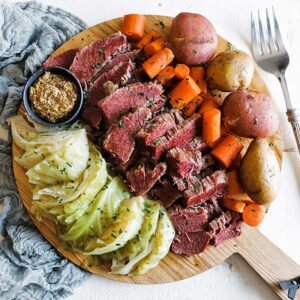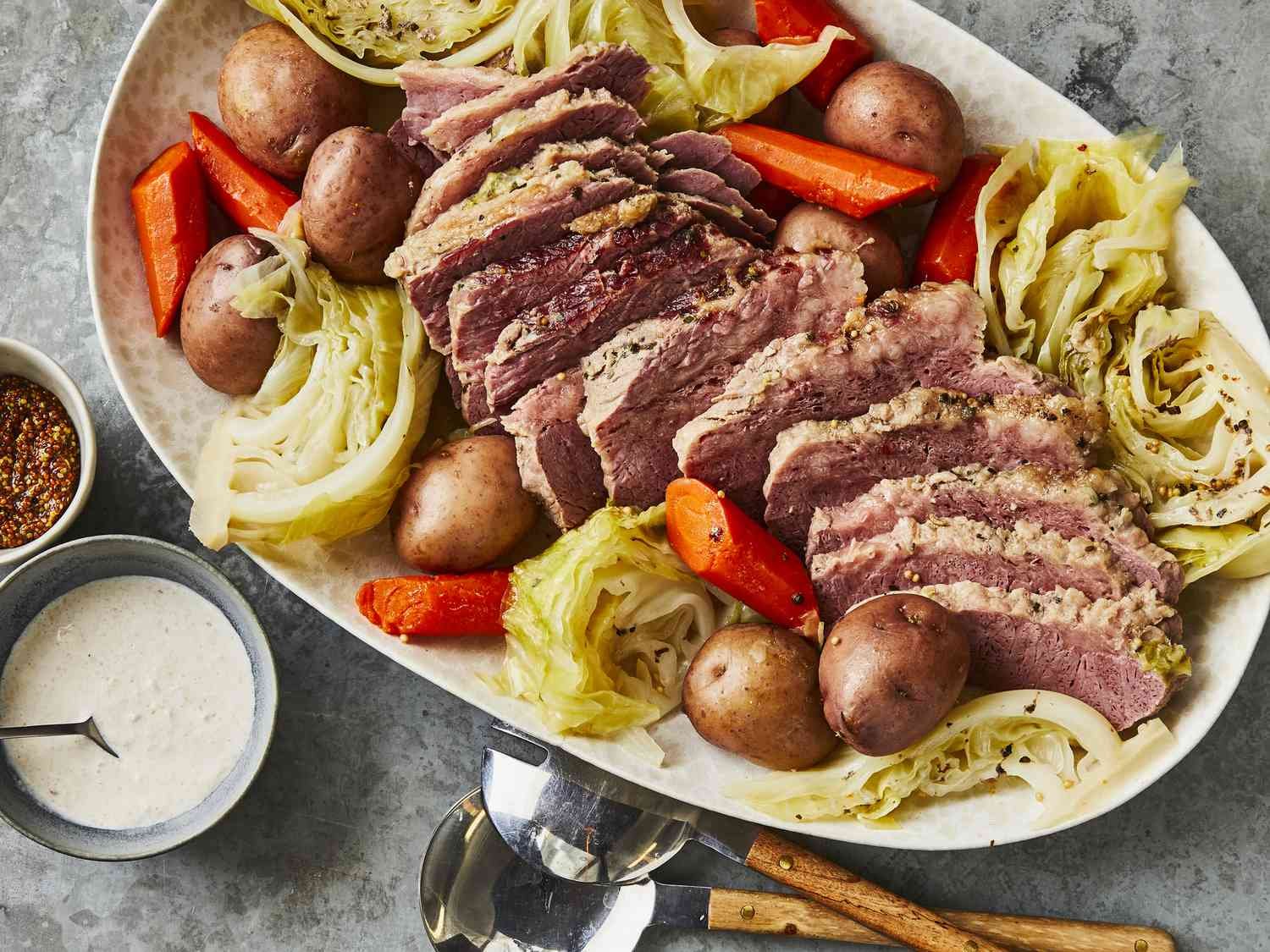A special place in culinary traditions is occupied by the classic dish corned beef and cabbage, especially during St. Patrick’s Day celebrations. This opulent and flavorful preparation showcases tender beef that has been brined with fragrant seasonings, accompanied by reassuring cabbage, potatoes, and carrots. This comprehensive tutorial will cover the historical background of corned beef, the brining process, detailed culinary instructions, creative variations, and practical advice on how to recreate this timeless dish at home.
The History and Origins of Corned Beef
Corned beef has a complex history spanning centuries, including cultural influences, preservation techniques, and culinary innovation.
1. Ancient Preservation Methods.
Before modern refrigeration, people used a variety of preservation methods to extend the shelf life of meat. Salting or “corning” meat entailed coating it with large granules of salt, which drew away moisture and hindered bacterial growth, so preserving the flesh.
2. European Influence and the Brining Tradition
The phrase “corned beef” is presumably derived from the coarse salt grains used in the curing process, which resemble corn kernels. As early as the Middle Ages, salt-cured beef was a popular method of preservation in Europe, particularly Ireland and England.
3. Irish Immigration and Culinary Adaptation
During the substantial influx of Irish immigrants to the United States in the 19th century, corned beef came to be closely associated with Irish-American cuisine, especially among the Irish-American population residing in urban regions where beef was more easily accessible compared to their native land. In particular, cabbage and corned beef have a long history of association with Irish-American culinary traditions, particularly on St. Patrick’s Day.

Chapter 2: How to Brin and Cure Corned Beef
Brining and curing the meat is the first step in creating tasty and tender corned beef. Understanding the procedures and components used is essential for attaining outstanding results.
1. Choosing the meat.
Brisket, a cut from the breast or lower chest of beef, has traditionally been used to make corned beef because of its rich flavor and texture. For variety, consider using additional cuts such as round or beef tongue.
2. Brine Ingredients
A basic corned beef brine normally contains kosher salt, sugar (brown or white), pink curing salt (sodium nitrite for color and preservation), and a pickled spice blend consisting of whole peppercorns, mustard seeds, coriander seeds, bay leaves, and cloves. For extra complexity, add garlic, juniper berries, and allspice berries.
3. Brining Process.
Make the brine by combining salt, sugar, pink curing salt, and spices in water to create a tasty solution.
Immerse the meat (brisket or chosen piece) in the brine, ensuring it is completely covered. Refrigerate the meat and let it marinate for a few days, usually 5-7 days, to ensure maximum flavor penetration.
4. Cooking Methods.
After brining, corned beef can be cooked in a variety of ways:
Simmer the corned beef in water or stock with extra aromatics (onions, carrots, celery) until soft.
Slow Cooking: Use a slow cooker or crockpot for hands-free cooking with tender results.
Pressure Cooking: Use a pressure cooker to cook faster while keeping moisture and taste.

The Classic Corned Beef and Cabbage Recipe
Now that you’ve brined your corned beef to perfection, it’s time to prepare a classic and cozy corned beef and cabbage dish that will satisfy your palate.
Ingredients:
3-4 pounds of corned beef brisket, brined and washed.
One large onion, peeled and quartered
3-4 carrots, peeled and sliced into pieces
Three to four peeled and quartered potatoes
One small head of cabbage, cored and cut into wedges.
For taste, use whole peppercorns, bay leaves, and brined pickled spices.
Instructions:
Put the rinsed corned beef brisket in a big pot or Dutch oven.
Add enough water or beef broth to cover the meat by at least one inch.
Add the quartered onions, carrots, potatoes, whole peppercorns, bay leaves, and pickling spices (from the brine) to the saucepan.
Bring the liquid to a boil over high heat, then lower to low and cover the saucepan.
Simmer slowly for 2.5–3 hours, or until the corned meat is tender. Skim off any froth or contaminants that come to the surface.
About 30 minutes before the corned beef is done, add the cabbage wedges to the stew and boil until soft but not mushy.
Once everything is cooked, gently take the corned beef, cabbage, and vegetables from the saucepan and place on a serving plate.
Slice the corned beef against the grain for optimal tenderness, then serve with the boiled cabbage, carrots, potatoes, and a ladle of the fragrant cooking stock.
Tips for the Perfect Corned Beef and Cabbage:
Rinse the brined corned beef before cooking to eliminate any extra salt from the surface.
Choose waxy potatoes, such as red or Yukon Gold, for improved texture retention during cooking.
Add more herbs, such as thyme or rosemary, for more scent and taste.
To add a spicy kick, serve with a dollop of grainy mustard or horseradish.
Creative Variations and Serving Ideas.

While the classic corned beef and cabbage meal is a tried-and-true favorite, experimenting with new variants and presentation ideas can add excitement and variety to your culinary experience.
1. Corned beef hash.
Making corned beef hash turns leftover corned meat and vegetables into a satisfying breakfast or brunch dish. Simply cut cooked corned beef and potatoes, sauté with onions until crispy, then top with a fried or poached egg.
2. Reuben sandwiches.
To make a wonderful Reuben sandwich, layer thinly sliced corned beef, Swiss cheese, sauerkraut, and Russian dressing (or Thousand Island dressing) on rye bread. Toast or grill until the cheese melts, then serve with a side of pickles or coleslaw.
3. Corned beef tacos/wraps
Shred leftover corned beef to use as a filling for soft tacos or wraps. A fusion of flavors can be achieved by adding cabbage slaw, avocado slices, and a drizzle of lime crema.
4. Irish-inspired Colcannon
Colcannon is a classic Irish side dish made by combining mashed potatoes, cooked cabbage (or kale), butter, cream, and onions. It mixes well with corned beef.
5. Beer-braised corned beef
For extra flavor, braise the corned meat in your favorite Irish stout or beer rather than water or broth. The malty flavors match the richness of the steak perfectly.
Chapter 5: Techniques for Perfect Corned Beef Mastery
To create the ideal corned beef and cabbage dish, pay close attention to detail and use a few insider suggestions. Here they are.
